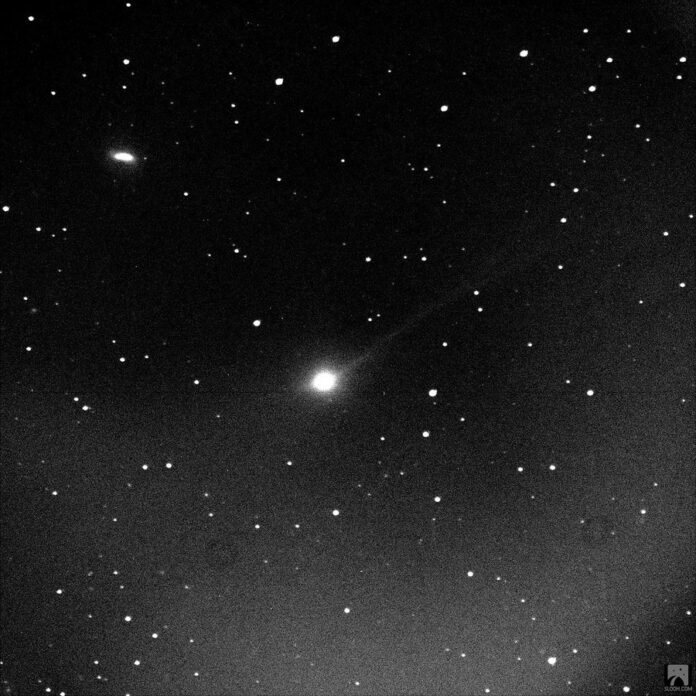
Key Findings
- What we’re seeing tonight challenges every natural explanation on the table.
- The dust and jet patterns refuse to behave like anything in our solar system.
- And the closer we get to December 19, the more 3IATLAS defies the rulebook of comets.
“The deeper we look, the stranger this interstellar visitor becomes — and today’s image raises the sharpest questions yet.”
USA HERALD – A brand-new image taken today, November 16, 2025, from the Canary One 0.5-meter telescope, has revealed something genuinely unsettling about interstellar visitor 3I/ATLAS. At first glance, it looks like a classic comet streaking across the dark — but the moment you examine the structure around the nucleus, the entire picture breaks away from anything that resembles ordinary comet physics.
The core glows with an unusually sharp intensity, surrounded by a hazy envelope that seems disturbed, as if material is being displaced in directions that cannot be explained by simple sunlight or solar wind.
As I examined the image with enhanced AI-tooling and forensic-resolution analysis, the dust pattern showed irregularities that do not match standard thermal behavior. Instead of a uniform outflow, the brightness gradients show directional asymmetry, like something is shaping or modulating the release rather than allowing it to disperse naturally.
The most striking feature is the dual-tail geometry. One tail extends away from the Sun — as expected — but it is so thin, so sharply defined, and so unusually narrow that it resembles a controlled jet more than a chaotic plume of dust.
The tail does not fan outward the way a natural dust plume should. Its edges remain unnaturally tight, creating the appearance of a guided wake rather than random particulate drift. Meanwhile, faint but unmistakable is the anti-tail: a structure pointing toward the Sun instead of away from it. Anti-tails can occur in rare natural cases when extremely tiny dust grains line up along the plane of the solar system, but the structure seen here is too straight, too refined, and too cleanly separated from the main plume to fit that explanation comfortably.
When my analysis mapped the dust density along the anti-tail, the distribution didn’t show the gradual fade that we would expect. It showed directionality — a tapering pattern consistent with material being propelled inward before being overtaken by solar radiation.
Even more unusual is the symmetry, or lack thereof. Natural comets produce jets that rotate, smear, and blend as the nucleus spins, creating blurred sectors of activity. But the November 16 image of 3I/ATLAS shows jet-like structures that hold their direction rather than bending or washing out over time.
For an object that should be tumbling through space, the persistence of these features raises questions about whether the nucleus is rotating unusually slowly… or whether something else is shaping the outflow. When we consider that 3I/ATLAS has already shown non-gravitational acceleration — a behavior that Avi Loeb and others have tied to unusual physics — these clean, persistent structures become even harder to dismiss.
The disturbed coma surrounding the nucleus is another anomaly. Its pixel-level noise signature reveals compression in one sector and a diffused spread in another, suggesting uneven heating or uneven material ejection. If this object were breaking apart, we would expect debris fans or brightness surges. But instead, the image shows something more controlled: deviations that look deliberate, as if the nucleus is venting selectively rather than fracturing chaotically.
Scientists have noted that 3I/ATLAS brightened dramatically near perihelion, and some argued that it might have partially disintegrated. But this image does not resemble the breakup debris field of a crumbling comet. Instead, it resembles an object maintaining structural coherence while emitting material through specific, repeating channels.
This brings us back to the broader puzzle of 3I/ATLAS — an interstellar object that has already thrown curveball after curveball since entering our solar system. Its non-gravitational acceleration, its unusual jet geometry, its light-absorption signatures at 1665 and 1667 MHz, its non-smearing jets, and now its November 16 twin-tail asymmetry have created a growing list of phenomena that natural models struggle to explain.
I want to be clear: I do not make claims lightly. But after examining hundreds of images, reviewing the peer-reviewed models, and analyzing brightness curves, this new observation adds yet another data point to an object that refuses to behave like ordinary ice and dust.
We are now just 33 days from December 19, when 3I/ATLAS will make its closest approach to Earth. Ground telescopes worldwide are beginning a fresh window of observation tonight, and the data they collect could clarify or complicate these mysteries even further. NASA has still not released its HiRISE images taken during the early government shutdown, despite growing calls from lawmakers and the scientific community for transparency.
The public deserves those images, and they matter more than ever now that each new observation raises new, harder questions. What happens next depends on what the world’s major observatories can capture over the coming weeks — and whether the agencies holding critical data finally decide to share it.
For now, the November 16 image stands as one of the clearest indications that this object is not behaving like the comets we grew up learning about. And until we have just-as-clear explanations, the mystery deepens.
OFFICIAL STATEMENTS:
“When an interstellar object refuses to conform to natural expectations, we must remain open to all explanations grounded in evidence.” — Harvard astrophysicist Avi Loeb
Editor’s Note: If you would like to share your astrophotography of 3I/ATLAS with USA Herald’s readers, then please send your photo(s), comments, and your name and location to Samuel Lopez.


